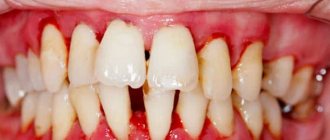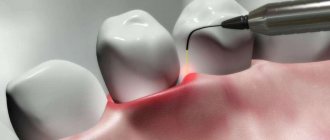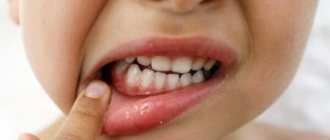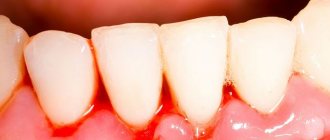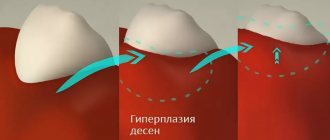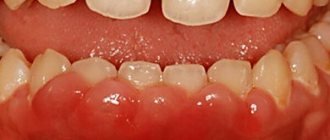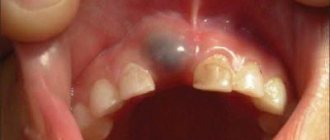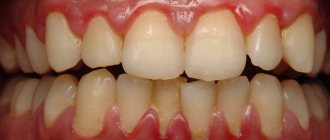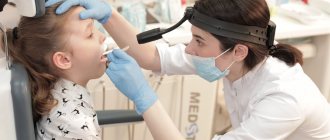Gingivitis is inflammation of the gums. The gums are inflamed in the vast majority of the world's population. Therefore, it is a common joke among dentists that it is possible to diagnose any patient, even if he did not have time to enter the office. This diagnosis, as you may have guessed, is “gingivitis.” This article will discuss the classification, pathogenesis and causes of gingivitis.
Gingivitis is the earliest stage of gum inflammation. Over time, the inflammation becomes more severe, the connection between the gum and tooth is destroyed (epithelial attachment - number 3 in the figure), and “gingivitis” changes to “periodontitis”.
To easily identify pathology, you need to remember the norm. Let's remember what a normal, non-inflamed gum looks like.
Causes of gingivitis
After eating food, plaque forms on the teeth. In the absence or insufficient oral hygiene, the plaque becomes denser and bacteria begin to actively multiply in it. Pathogenic microorganisms penetrate the gums and cause inflammation. There are many provoking factors that increase the risk of developing the disease.
External reasons include:
- insufficient hygiene, infections - inflammatory processes occur due to food debris, bacteria from dirty hands, toothbrushes, toys, pacifiers, spoons, in the presence of childhood infectious diseases - scarlet fever, chickenpox, rubella and similar pathologies;
- tartar is a compacted plaque that is deposited in periodontal pockets, injuring and infecting soft tissues;
- advanced caries is a source of infection;
- poor-quality dental treatment - injuries to the mucous membranes, incorrectly installed fillings, dentures (bulge and injure the gums), insufficient antiseptics, implant rejection;
- injury to soft tissues when cleaning with hard brushes or hard food;
- chemical injuries from medications, hot spices, food acids, and other substances;
- poisoning with heavy metals (lead, mercury, etc.);
- cigarette smoke reduces the level of local immunity, impairs tissue nutrition, salivation, and acts as an irritant;
- impaired nasal breathing contributes to dry mucous membranes, which means increases the risk of infection.
Pathology can be caused by internal causes:
- anomalies in the development of teeth, jaws, malocclusion - injuries to the mucous membranes when chewing food;
- eruption of teeth - injury from the inside;
- diseases of the gastrointestinal tract, helminthic infestations lead to a deficiency of nutrients, vitamins, decreased salivation, and immunopathological reactions;
- vitamin deficiency, especially lack of vitamins C, E, A, group B;
- decreased immunity, chronic respiratory diseases, hepatitis, immunodeficiency, tuberculosis;
- diabetes mellitus, hormonal disorders during pregnancy, thyroid disease, decreased production of sex hormones.
The answer to the question whether gingivitis is contagious cannot be unambiguous. Inflammation in the oral cavity is most often provoked by staphylococcus, streptococcus, candida fungi, herpes virus, and E. coli. However, provoking factors are required for the development of the disease. If a person has a strong immune system and regularly takes care of his teeth, then pathology will not arise.
Prices
| Name of service | Price, rub.) * |
| Comprehensive oral hygiene (OptraGate oral cavity isolation, AirFlow removal of colored plaque, ultrasonic removal of dental plaque, polishing with paste, preventive fluoridation of teeth) | 7,000 rub. |
| Initial consultation with a dentist-therapist | 1,500 rub. |
| Repeated consultation with a dentist-therapist | 800 rub. |
We accept VISA, MASTERCARD, MAESTRO bank cards for payment.
Would you like us to call you back?
Symptoms and signs
The pathology can be easily detected by traces of blood on the toothbrush - the main sign of gingivitis. The more pronounced the inflammatory process, the more severe the bleeding of the gums. In advanced cases, bleeding can occur even without mechanical impact, especially after waking up from sleep. Depending on the type of disease, symptoms may vary.
The disease is characterized by:
- swelling, redness, swelling, bleeding gums;
- pain due to mechanical impact, eating hot, cold or spicy food;
- unpleasant odor that cannot be eliminated by hygiene products;
- ulcers, ulcers (for some types);
- symptoms characteristic of intoxication - fever, nausea, loss of appetite, weakness.
If left untreated, gum pockets may form. The infection penetrates deeper, affecting the periodontium. This threatens the development of severe complications and tooth loss.
Diagnostic methods
A visual examination by a dentist may be sufficient to assess the disease. If symptoms are severe, the doctor may refer the patient for an x-ray. This is necessary if infection of the pulp, periodontal and bone tissue is suspected.
In the presence of ulcers or chronic inflammation, a microbiological analysis is performed, which identifies the type of bacteria and their resistance to antibiotics. If a generalized form is diagnosed, then additional diagnostics are carried out by relevant specialists: ENT doctor, gastroenterologist, immunologist, and other specialists. The patient donates blood for general tests, sugar, HIV infection, syphilis.
Types of gingivitis
The disease is classified according to its course, localization of the inflammatory process, severity, pathological changes in tissues, and causes of development. How to treat gingivitis depends on the type of pathology, so differential diagnosis is important.
Forms for localization of pathology
For correct diagnosis and correct treatment, an important indicator is the prevalence of the disease.
Gingivitis can be:
- Localized - inflammatory processes affect only a small area of soft tissue near one or several teeth.
- Generalized - all gums and mucous membranes of the mouth become inflamed. Often associated with other infectious and systemic diseases.
Catarrhal gingivitis
It can be acute or chronic. Serous inflammation of the gums - formation of exudate, swelling, hyperemia, bleeding, pain. The most common form of pathology - up to 90% of all clinical cases.
Acute form
It is more often diagnosed in children, adolescents, and young people under 30 years of age. It develops quickly and has pronounced symptoms. The gums bleed heavily, become painful, become loose, and occasional small ulcers may appear. After treatment they recover completely. If left untreated, the disease may become chronic.
Acute necrotizing ulcerative gingivitis
The ulcerative-necrotic form is otherwise called Vincent gingivitis. Has a severe course. The symptoms are pronounced. The disease is accompanied by necrosis of the interdental papillae, increased temperature, enlarged regional lymph nodes, and symptoms of intoxication. Separately classified according to ICD-10.
Chronic form
Inflammatory processes have a sluggish course, symptoms are mild or absent. Bleeding occurs regularly when brushing your teeth. May be accompanied by an unpleasant odor and metallic taste. During an exacerbation, the mucous membranes become red, swell, and pressure is felt from the inside. Usually there is a dense plaque and tartar on the teeth.
Types of chronic course:
- Desquamative - abundant desquamation of the epithelium of the gum mucosa, severe redness of the surface layer of soft tissue.
- Ulcerative - formation of ulcers, burning, itching, bleeding.
- Hyperplastic (hypertrophic) - the volume of the papillae increases, false pathological periodontal pockets are formed, blood and purulent contents are released, the mucous membranes acquire a purple-bluish tint. The gum grows, covering the crown of the tooth. Hyperplasia is diagnosed in three stages of severity; in the third, more than half of the crown is closed.
- Simple marginal - occurs more often than other species. It has standard clinical symptoms - bleeding, swelling of the gum tissue, pain when chewing, and unpleasant odor. Usually diagnosed in childhood with insufficient oral hygiene.
- Atrophic - characterized by reduction (dystrophy) of the gums. Symptoms are mild or absent, since no inflammation is observed. Over time, the interdental papillae disappear, exposing the neck and roots of the tooth. It occurs in old age, less often in young people with anomalies in the development of the dental system or incorrect orthodontic treatment.
Hormone-modulated gingivitis
Hormones and their ratio in the body do not directly affect the development of the disease. However, hormonal imbalances can become a provoking factor in the presence of dental plaque or lack of proper hygiene.
Depending on the causes of hormonal imbalances, there are:
- gingivitis in pregnant women;
- pubertal at puberty;
- when taking contraceptives.
The classification of gingivitis also includes types such as lymphocytic, plasmacytic, viral, herpetic and other varieties.
Forms of the disease
In dentistry, there are two main forms of the disease:
- acute catarrhal gingivitis. This is a pronounced one-time inflammation of the gums, which has a temporary limitation and can develop into a more serious form;
- chronic inflammation. It develops when the acute stage is ignored and self-medication; it is a low-grade inflammation. It recurs periodically and requires repeated treatment.
In terms of prevalence, gingivitis can be localized, when 1-3 gums become inflamed, and generalized, in which the entire tissue of the dentition or both jaws is affected.
Treatment methods
With early diagnosis of the disease, gum health can be completely restored in 7 to 10 days. If gingivitis is not cured in a timely manner, long-term therapy will be required. Treatment methods depend on the type, severity of the pathology, causes of development, and age of the patient.
The complex of treatment measures includes:
- professional hygiene in dental clinics to clean teeth from deposits and stones;
- sanitation of the oral cavity to remove pathogenic microorganisms and their metabolic products;
- taking vitamins, antihistamines, antioxidants and other medications prescribed by a doctor;
- rinsing the mouth with solutions for antiseptics, relieving inflammation, accelerating tissue healing;
- surgical operations for hypertrophic, atrophic forms (excision or augmentation of gums);
- correction of hygiene procedures - replacing a hard brush with a soft one, consulting a dentist on proper oral care and nutrition.
For inflammatory gum disease, traditional medicine methods can and should be used. How to rinse your mouth with gingivitis? Doctors recommend using decoctions of chamomile, sage, calendula, and oak bark. If there are no herbs, you can prepare a soda solution. Rinse should be done after every meal.
How and with what to treat catarrhal gingivitis?
Diagnosis of catarrhal gingivitis is not difficult; chronic gingivitis is clearly visible to the naked eye. To be sure, you can do a number of specific tests - and when they confirm the diagnosis, prescribe treatment. It will consist of the following stages.
- Eliminating the cause of gingivitis. This could be cleaning teeth from plaque and tartar, removing an incorrect filling, reinstalling a denture, taking a course of vitamins, etc. Very often, signs of gingivitis begin to disappear without a trace immediately after the removal of tartar.
- If recovery is slow, rinsing with a disinfectant solution is prescribed - usually a 0.06% chlorhexidine solution, but there may be other antiseptics - at the discretion of the doctor. Gargles with medicinal herbs and medicinal applications to the gums of chlorophyllipt, propolis, and special ointments can also be prescribed.
- If this is not enough, treatment is carried out with antibiotics, non-steroidal anti-inflammatory drugs, as well as gum massage, electrophoresis, etc.
There are also folk methods for treating chronic catarrhal gingivitis - rinsing with natural antiseptics brewed in milk - chamomile, sage, oak bark infusion. But you need to keep in mind that these medications alone will not eliminate the cause of gingivitis, so it will start again and again until you see a dentist. However, such remedies are excellent for consolidating the resulting therapeutic effect and preventing relapses of the disease.
There is another method of treating chronic gingivitis - injections of autoplasma containing platelets. So far, this method is rarely used as research into its effectiveness continues.
How to treat gingivitis in each specific case, and how long the treatment process will last, should be determined by the dentist. After all, the patient can be content with the disappearance of external signs of gingivitis, while the inflammatory process will continue, threatening complications.
If you have a problem similar to that described in this article, be sure to contact our specialists. Don't diagnose yourself!
Why you should call us now:
- We will answer all your questions in 3 minutes
- Free consultation
- The average work experience of doctors is 12 years
- Convenient location of clinics
Single contact phone number: +7
Make an appointment
